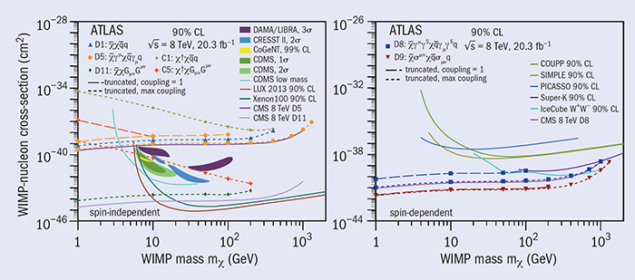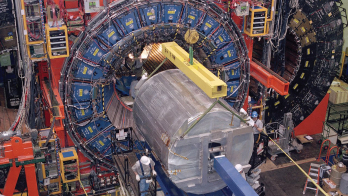There is evidence for dark matter from many astronomical observations, yet so far, dark matter has not been seen in particle-physics experiments, and there is no evidence for non-gravitational interactions between dark matter and Standard Model particles. If such interactions exist, dark-matter particles could be produced in proton–proton collisions at the LHC. The dark matter would travel unseen through the ATLAS detector, but often one or more Standard Model particles would accompany it, either produced by the dark-matter interaction or radiated from the colliding partons. Observed particles with a large imbalance of momentum in the transverse plane of the detector could therefore signal the production of dark matter.
Because radiation from the colliding partons is most likely a jet, the “monojet” search is a powerful search for dark matter. The ATLAS collaboration now has a new result in this channel and, while it does not show evidence for dark-matter production at the LHC, it does set significantly improved limits on the possible rate for a variety of interactions. The reach of this analysis depends strongly on a precise determination of the background from Z bosons decaying to neutrinos at large-boson transverse-momentum. By deriving this background from data samples of W and Z bosons decaying to charged leptons, the analysis achieves a total background uncertainty in the result of 3–14%, depending on the transverse momentum.

To compare with non-collider searches for weakly interacting massive particle (WIMP) dark matter, the limits from this analysis have been translated via an effective field theory into upper limits on WIMP–nucleon scattering or on WIMP annihilation cross-sections. When the WIMP mass is much smaller than several hundred giga-electron-volts – the kinematic and trigger thresholds used in the analysis – the collider results are approximately independent of the WIMP mass. Therefore, the results play an important role in constraining light dark matter for several types of spin-independent scattering interactions (see figure). Moreover, collider results are insensitive to the Lorentz structure of the interaction. The results shown on spin-dependent interactions are comparable to the spin-independent results and significantly stronger than those of other types of experiments.
The effective theory is a useful and general way to relate collider results to other dark-matter experiments, but it cannot always be employed safely. One advantage of the searches at the LHC is that partons can collide with enough energy to resolve the mediating interaction directly, opening complementary ways to study it. In this situation, the effective theory breaks down, and simplified models specifying an explicit mediating particle are more appropriate.
The new ATLAS monojet result is sensitive to dark-matter production rates where both effective theory and simplified-model viewpoints are worthwhile. In general, for large couplings of the mediating particles to dark matter and quarks, the mediators are heavy enough to employ the effective theory, whereas for couplings of order unity the mediating particles are too light and the effective theory is an incomplete description of the interaction. The figures use two types of dashed lines to depict the separate ATLAS limits calculated for these two cases. In both, the calculation removes the portion of the signal cross-section that depends on the internal structure of the mediator, recovering a well-defined and general but conservative limit from the effective theory. In addition, the new result presents constraints on dark-matter production within one possible simplified model, where the mediator of the interaction is a Z’-like boson.
While the monojet analysis is generally the most powerful search when the accompanying Standard Model particle is radiated from the colliding partons, ATLAS has also employed other Standard Model particles in similar searches. They are especially important when these particles arise from the dark-matter interaction itself. Taken together, ATLAS has established a broad and robust programme of dark-matter searches that will continue to grow with the upcoming data-taking.








